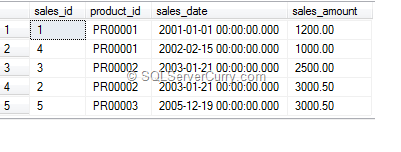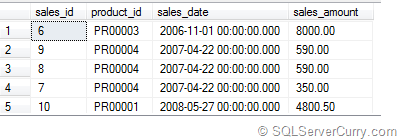Consider the following set of data
create table testing
(
sales_id int,
product_id char(7),
sales_date datetime,
sales_amount decimal(12,2)
)
insert into testing(sales_id,product_id,sales_date,sales_amount)
select 1,'PR00001','2001-01-01',1200.00 union all
select 2,'PR00002','2003-01-21',3000.50 union all
select 3,'PR00002','2003-01-21',2500.00 union all
select 4,'PR00001','2002-02-15',1000.00 union all
select 5,'PR00003','2005-12-19',3000.50 union all
select 6,'PR00003','2006-11-01',8000.00 union all
select 7,'PR00004','2007-04-22',350.00 union all
select 8,'PR00004','2007-04-22',590.00 union all
select 9,'PR00004','2007-04-22',590.00 union all
select 10,'PR00001','2008-05-27',4800.50
Let us assume that you want to return the first 5 rows from the results ordered by sales_date
SQL Server
Version 2012 onwards you can use OFFSET and FETCH NEXT Clauses
select * from testing
order by sales_date
offset 0 rows
fetch next 5 rows only
The above code orders the results by ascending order of sales_date and fetches 5 rows. The next 5 rows can be returned using the following code
select * from testing
order by sales_date
offset 5 rows
fetch next 5 rows only
The FETCH clause skips the first 5 rows and returns the next five rows

MySQL
The same functionality can be done in MySQL using the LIMIT clause
select * from testing
order by sales_date
LIMIT 0,5
The above code returns first five rows in ascending order of sales_date. To get next five rows, use the following code
select * from testing
order by sales_date
LIMIT 5,10


2 comments:
Very good article
The pagination with limit and offset is a very limited example. I understand it is meant to show an example of how you can do it but this generally wouldn't be the best way to execute pagination. Check out these slides Yahoo provided on using limit and ids with as an alternate way of implementing it in MySQL.
http://www.slideshare.net/suratbhati/efficient-pagination-using-mysql-6187107
Post a Comment